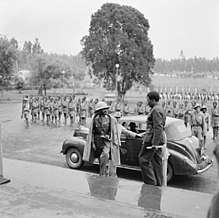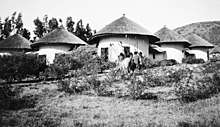History of Addis Ababa
The history of Addis Ababa, Ethiopia, formally begins with the founding of the city in the 19th century by Ethiopian Emperor Menelik II and his wife Empress Taytu Betul.


History
The history of Addis Ababa began after Taytu and Minilik got interested to the beautiful land scape Which has been also called Finfinnee[1] Before the advent of Addis Ababa, there were many sites in the surrounding areas that had been used as temporary capitals for the Kingdom of Shewa. Ankober, a site about 160 km north of Addis Ababa, served as the capital of the kingdom of Shewa during the second half of the 18th century. As evidence, the ruins of the palace are still found on the lip of the great escarpment, which is popular in its breath-taking view. The village of Aliyu Amba, which was the most important market center of the Shewa Kingdom, is also located below Ankober palace at one of the broken hills. Other areas, like Wechecha, Yerrer and Entoto were also temporarily used as capitals of the Shewan Kingdom.[2][3]
Menelik, as Negus[nb 1] of Shewa, had found Mount Entoto a useful base for military operations in the south of his realm. In 1879, Menelik visited the reputed ruins of a medieval town and an unfinished rock church that showed proof of an Ethiopian presence in the area prior to the campaigns of Ahmad Gragn. His interest in the area grew when his wife Taytu began work on a church on Entoto. In addition, Menelik endowed a second church in the area. In 1881, Menelik moved the capital of Shewa from Ankober to Entoto.[4]
The immediate area around Entoto did not encourage the founding of a town due to the lack of firewood and water. In 1886, the actual settlement began in the valley south of the mountain. Taytu initially built a house for herself near the Filwoha hot mineral springs, where she and members of the Shewan royal court liked to take mineral baths. Soon, other members of the Shewan nobility and their staffs and households settled the vicinity. Negus Menelik expanded his wife's house to become the Imperial Palace, which remains the seat of government in Addis Ababa today. Between 1889 and 1891, Addis Ababa became Ethiopia's capital when Menelik II became Emperor of Ethiopia. One of Emperor Menelik's contributions that is still visible today is the planting of numerous eucalyptus trees along the city streets.[3][2]
After becoming the capital of Ethiopia, Addis Ababa grew by leaps and bounds and took on the character of a boomtown. By 1910, the city had approximately 70,000 permanent inhabitants and also had between 30,000 and 50,000 temporary inhabitants. Addis Ababa became the site of many of Ethiopia's innovations. Because of the sizeable population of Addis Ababa, a degree of labor specialization not seen elsewhere in the empire was possible.[5] The rapid growth of Addis Ababa, especially soon after the Battle of Adwa, was accompanied by the construction of some of Ethiopia's first modern bridges.[6]
On 5 May 1936, Italian troops occupied Addis Ababa during the Second Italo-Abyssinian War, making it the capital of Italian East Africa. Addis Ababa was governed by the Italian Governors of Addis Ababa from 1936 to 1941. In those five years the Italian government made many improvements to the city, from the construction of Hospitals and roads to the creation of stadiums like the Addis Ababa Stadium.[7]
After the Italian army in Ethiopia was defeated by the British army (with the help of Arbegnoch[nb 2]), during the Liberation of Ethiopia, Emperor Haile Selassie returned to Addis Ababa on 5 May 1941—five years to the very day after he had departed—and immediately began the work of re-establishing his capital.[3][2]
Emperor Haile Selassie helped form the Organization of African Unity in 1963, and invited the new organization to keep its headquarters in the city. The OAU was dissolved in 2002 and replaced by the African Union (AU), also headquartered in Addis Ababa. The United Nations Economic Commission for Africa also has its headquarters in Addis Ababa. Addis Ababa was also the site of the Council of the Oriental Orthodox Churches in 1965.[3] [2][8]
.jpg)
See also
Notes
- Roughly equivalent to King.
- Equivalent to Ethiopian patriots.
References
- Indigenous Oromo Community Currently Living around the Addis Ababa
- "Addis Abeba in "Enciclopedia dei ragazzi"". www.treccani.it.
- "Addis Ababa - national capital, Ethiopia".
- Pankhurst, p. 195
- Pankhurst, p.195
- Pankhurst, p. 196
- Podesta: "Family and Society in Italian Africa"
- "Addis Abeba, Ethiopia" (PDF). inura.org.
Bibliography
- Pankhurst, Richard (2001). The Ethiopians: A History (Peoples of Africa). Wiley-Blackwell; New Ed edition. ISBN 0-631-22493-9.
External links
